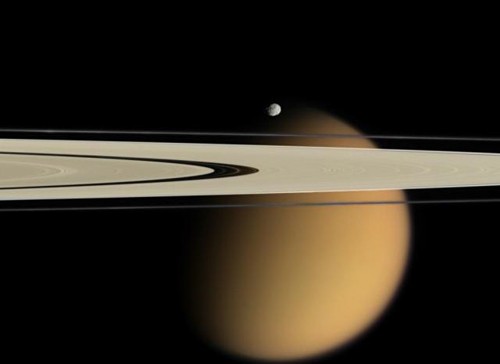Life on other planets? Maybe. Brown, gunky stuff on other planets? Yes.
A UA research team has discovered that bombarding a nitrogen-rich gas mixture, designed to mimic the atmosphere of Saturn’s moon, Titan, with high-energy ultraviolet radiation can produce the nitrogenated organic compounds that are thought to be life’s first ingredients.
Titan’s atmosphere is of special interest to scientists because aside from Earth, it is the only known planetary-sized body with a substantial amount of nitrogen in its atmosphere. As such, it provides an elucidating model of the chemical conditions of ancient Earth.
The new research is the first experimental evidence of how high-energy UV radiation, an abundant resource in the upper atmospheres of Earth and Titan, can induce complex organic compounds to combine with nitrogen, a necessary ingredient of life. The process through which organic compounds were first coaxed into incorporating nitrogen has been a persistent mystery to scientists investigating the origin of life.
In order to simulate the high-energy photons that bombard Titan’s upper atmosphere in the form of sunlight, the UA research team used the Advanced Light Source at Lawrence Berkeley National Laboratory’s synchrotron particle accelerator.
“”What’s unique in our experiment is the use of very high-energy photons to break the nitrogen molecule. The nitrogen molecule is very stable so the radiation has to be very energetic to break it,”” said Hiroshi Imanaka, who was a member of the UA’s chemistry and biochemistry department at the time of the experiment and is now an assistant research scientist in the UA’s Lunar and Planetary Laboratory.
Imanaka conducted the experiment in Berkley, Calif., with the help of Mark Smith, a UA professor of chemistry and lunar and planetary sciences. They used the synchrotron to send a beam of accelerated photons into a stainless steel cylinder containing a mixture of nitrogen and methane gases meant to resemble the chemical makeup of Titan’s atmosphere.
The energetic photons are necessary to jump-start the formation of nitrogenated organic compounds because they break down the nitrogen molecules into a simpler, more reactive form.
“”High-energy photons, like the ones we used, are actually a natural energy source in Titan’s upper atmosphere because they arrive in the sunlight,”” said Imanaka. “”After those high-energy photons break down the nitrogen molecules, the dissociated nitrogen is free to participate in the formation of complex organic compounds.””
After bombarding the contents of the cylinder with the photons, Imanaka initially had trouble locating any nitrogenated compounds. He analyzed the gaseous contents of the cylinder using a mass spectrometer and detected no nitrogen. However, when he analyzed the pieces of brown, gunky material that had collected on the walls of the cylinder, he found the nitrogen he was looking for.
While Imanaka is careful to explain that he and Smith have not succeeded in “”making life”” or proving that there is life on Titan, he admits that there are likely nitrogenated compounds similar to the ones that they produced in the lab scattered on Titan’s surface. The compounds fall to the surface after they are created in the atmosphere.
“”There are going to be nitrogenated organic compounds that have accumulated on Titan’s surface over time, and they give the minimum condition for the eventual evolution of life,”” Imanaka said.
Imanaka said there are space missions in the planning stages that could give scientists the chance to study Titan’s atmosphere up close. His research will help to inform the observational objectives of the missions and the development of the instruments that will allow scientists to effectively study Titan’s atmosphere from space.









